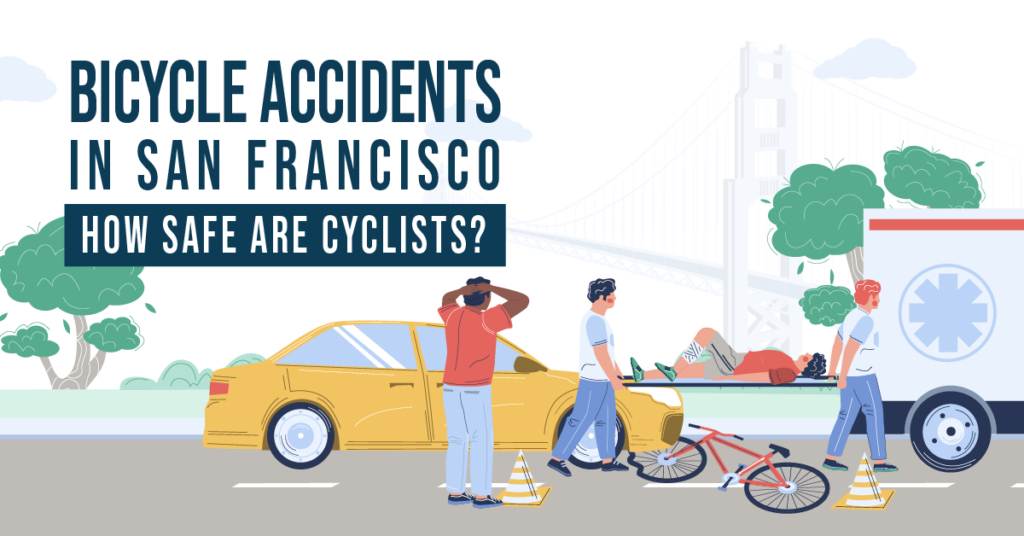
What’s the most bike-friendly city in the U.S.?
While Minneapolis and New York rank high on the list, San Francisco in California takes the cake—and that’s no surprise. Bicycling in San Francisco is a vibrant culture, with thousands of residents taking their bicycles daily for commutes, exercise, and leisure.
However, the city also has a high incidence of bicycle accidents. Despite a significant drop in fatalities and injuries, there were still 377 bike-related cases in 2022. Meanwhile, the local government aims to reduce traffic accidents through the Vision Zero SF initiative and make cycling in San Francisco safer for everyone.
Let’s delve into bike accidents in San Francisco to help protect yourself and others on the road.
Bicycle Accidents in San Francisco: By the Numbers
What are the chances of becoming a bicycle crash victim in San Francisco? Here are some key statistics to stay in the know.
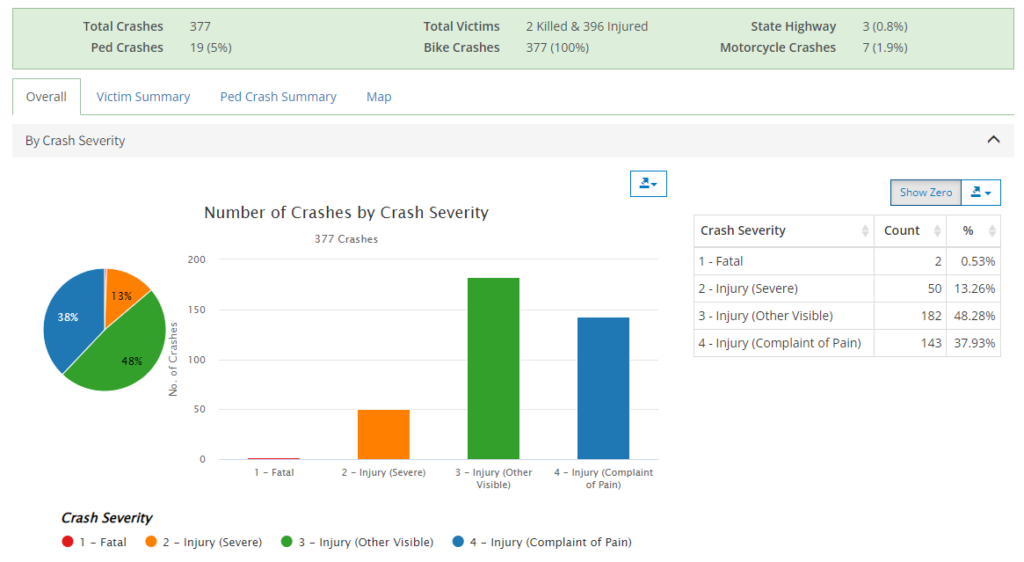
- 377 bicycle accidents occurred in San Francisco in 2022, resulting in two fatalities (0.53%) and 375 (99.47%) reported injuries (complaints of pain, severe, and other visible (Transportation Injury Mapping System)
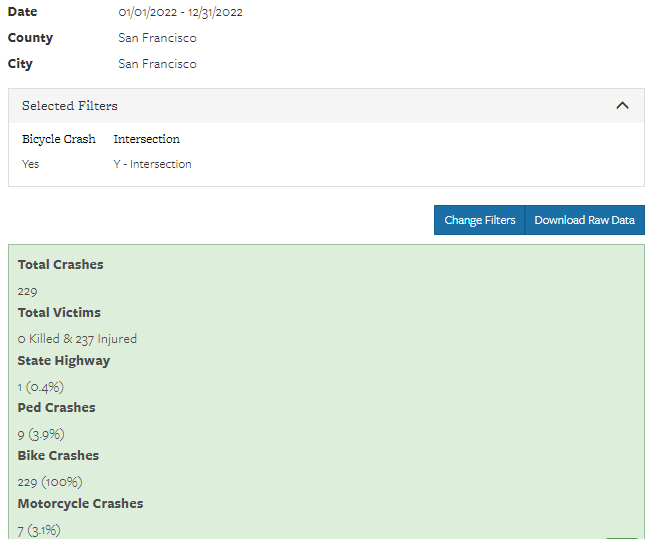
- 229 (60.74%) of these accidents occurred in intersections (TIMS)
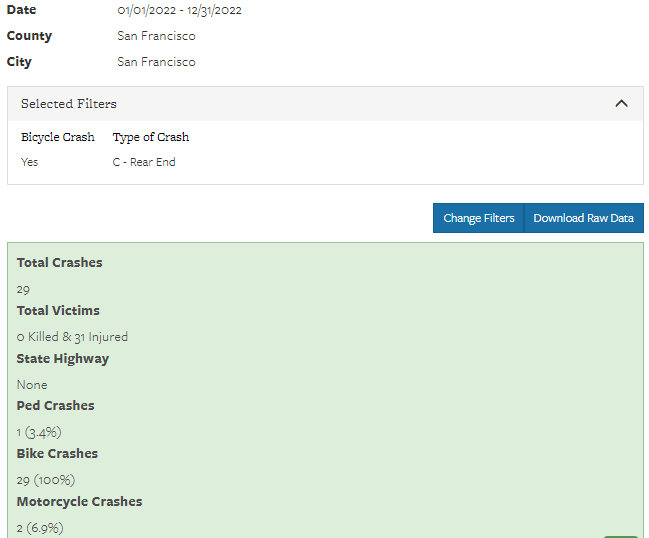
- 29 (7.69%) were rear-end accidents, while 316 (83.82%) were hit-and-runs (TIMS)
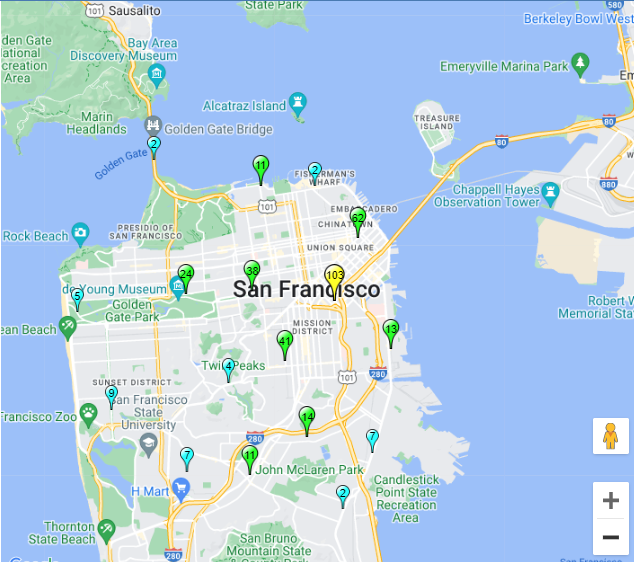
- 103 (27.32%) took place near downtown San Francisco (TIMS)
- 276 (69.35%) of all bicycle accidents in San Francisco involved male cyclists, while 75 (18.84%) involved females (TIMS)
- 65 (16.33%) of these accidents involved a victim between the ages of 30 to 34 (TIMS)
- 68% of single-bike crashes resulted from wet and slippery roads (Accident Analysis & Prevention via ScienceDirect)
- 19% of cycling accidents in the dark result from poor visibility (Accident Analysis & Prevention via ScienceDirect)
4 Types of Bicycle Accidents
Understanding the various types of bike accidents can help you stay alert and avoid them.
1. Intersection accidents
Many cyclists agree that traversing through busy road intersections is daunting, and for a good reason. Most bicycle-related accidents occur in non-intersection areas (60.74%), resulting in severe injuries. These cases may range from a car hitting a cyclist or vice versa to a cyclist hitting a crossing pedestrian.
2. Dooring accidents
If a car owner opens the door without checking for oncoming traffic, including cyclists, they risk causing a dooring accident. It’s a common occurrence that could damage both the bicycle and car, not to mention result in injuries. It also can be fatal, depending on the biker’s speed and if they hit other vehicles after bouncing from the car door.
3. Rear-end accidents
Failing to establish a safe braking distance on the road may lead to rear-end accidents, which account for 7.69% of bicycle crashes within San Francisco in recent years. It occurs when a car hits a bicycle from behind or vice versa, resulting in damage between the vehicles. Depending on the speed at which it happens, it could also cause personal injury to the cyclist.
4. Hit-and-run accidents
People who cause biking accidents may panic and leave without attempting to stop and resolve the issue. These hit-and-run accidents comprise 83.82% of bike crashes in San Francisco, resulting in prolonged cases since law enforcement has to search for the runner.
Note that running from the scene is a misdemeanor—the California Vehicle Code (CVC) Section 20002 states that a conviction results in jail time and a fine.
6 Tips for Cyclists to Stay Safe
No matter how careful you are when cycling, there’s no way to predict others’ behavior on the road. Remember these tips to reduce the likelihood of accidents and stay safe.
1. Wear a helmet
Unlike cars, a bike can’t cushion you from impact. Instead, you only have helmets to protect your head from crashes and falls. Data shows that bike helmets are roughly 85% successful in preventing head and brain injuries, so never bike without one, even for short rides. CVC Section 21212 even requires minors to wear a helmet when cycling.
Pick a high-quality helmet for a safer and more comfortable fit. It should be snug, with the front edge an inch above your eyebrows. If the helmet easily shifts when you move, tighten it to keep it from falling off during impact. Moreover, choose helmets with genuine safety ratings, including Consumer Product Safety Commission (CPSC) and Snell certifications, which indicate that they underwent rigorous safety testing.
2. Use bike lanes and paths
Bike lanes are an integral part of San Francisco’s transportation infrastructure as the city promotes cycling as a safe and sustainable way to go around. Stay on the bike lanes and paths when you’re out for a ride to reduce the risk of accidents—they’re usually painted green for better visibility. Then, if you get hit by an out-of-place vehicle, you have grounds to file a winning lawsuit.
Fortunately, San Francisco has been actively expanding its bike lane network as part of its Vision Zero initiative. The city is improving cycling infrastructure, including traffic bollards separating cyclists from other vehicles, so you can enjoy a safer ride. Check out San Francisco’s Bike Network Map to find the nearest cycling lanes and paths along your routes.
That said, CVC Sections 22100 and 21717 require motorists to merge into bike lanes for right turns, so stay alert, maintain a safe and constant speed, and keep watch of the vehicles ahead to avoid crashes.
3. Install lights and reflectors
Bikes generally don’t include lights upon purchase. When cycling at night or in low-light conditions, it will be difficult to see them—a problem accounting for 19% of cycling accidents at dark. Even worse, many cyclists don’t bother installing lights and reflectors.
Do better and install lights and reflectors around your bike to improve everyone’s visibility and reduce the likelihood of accidents. CVC Section 21201 also requires bicycles operating on highways, bike lanes, and paths to have all of the following equipment:
- A front-facing white lamp illuminating 300 ft in front of the bicycle
- A rear-facing red reflector or solid or flashing red light with a built-in reflector visible from 500 ft. from the back
- A yellow or white reflector on each pedal, shoe, or ankle visible from 200 ft. from the front and back
- A yellow or white reflector on each side of the bike’s front center and a white or red reflector on each side of its rear center
4. Follow traffic rules
Accidents are often a result of drivers and bikers failing to follow traffic rules, so staying alert and focusing on the road significantly reduces the risk. Still, many drivers and bikers fail to do so. Crashes due to distraction result in thousands of injuries and fatalities. While you can’t control other people’s driving behavior, do your part to make travel safer by following traffic rules.
For starters, protect yourself by wearing a helmet and using lights and reflectors in low-light conditions to improve visibility. As per CVC Section 22108, instead of turn signals, use hand signals at least 100 ft. before turning or changing lanes to warn surrounding traffic about your movements, but leave one hand on the handlebars to maintain control.
It’s also crucial to obey right-of-way, which includes respecting pedestrian lanes and sidewalks, stop signs and other traffic signs, riding on the correct side of the road, and following traffic lights.
5. Be aware of your surroundings
Bikes are generally silent and have lower profiles than other vehicles, especially at night, which often places cyclists at risk on busy roads. However, being a defensive rider and aware of your surroundings ensures cycling safety.
Stay alert and watch out for cars and pedestrians that could hit you, and vice versa. Look for obstacles, including potholes, trash, and open car doors you might crash into. To avoid getting inadvertently hit, be aware of other vehicles’ blind spots, especially trucks or buses. Also, slow down when approaching intersections and ensure there isn’t any oncoming traffic that can’t see you.
Lastly, CVC Section 27400 discourages using distracting activities, such as listening to music on earphones or talking on the phone while pedaling. These distractions limit your ability to hear audio cues, like car horns and incoming traffic, which could result in a potentially fatal accident.
6. Be prepared for weather conditions
Unlike cars, bikes can’t shield you from weather conditions. To keep yourself safe, wear weather-appropriate clothing and equipment. Bring a raincoat or waterproof jacket to protect yourself if there’s a downpour, and wear cycling glasses to keep water away from your eyes and help you focus on the road.
Moreover, be extra careful when riding in wet or slippery conditions, which accounts for 68% of single-bike crashes.
Hot weather also poses a risk to bikers. Sunlight could block your vision and cause you to hit something or someone, so wear dark sunglasses to protect your sight. Wear light clothing and bring a water bottle to keep yourself cool, as intense heat may cause dizziness, headaches, and nausea that could confuse you and lead to an accident.
Navigating Bicycle Accidents
Although the city of San Francisco is a haven for cyclists, it’s still important to be alert while riding to ensure safety. In effect, you help significantly reduce bicycle accidents and create a safer environment for all road users.
Were you involved in a bike-related accident and currently require a personal injury attorney? Reach out to us at RMD Law. Our experienced lawyers are ready to guide you through the legal process and provide the tireless representation you deserve.
Contact us for a free case evaluation.
- Car Accidents in San Francisco County: Statistics, Intersection Data, and More - March 1, 2024
- 7 Things Covered Under the Good Samaritan Law in California - February 29, 2024
- California Wrongful Death Law: What Is It and How to File A Claim - February 21, 2024

